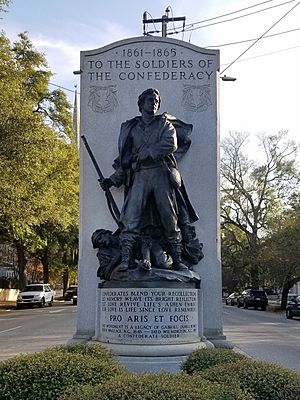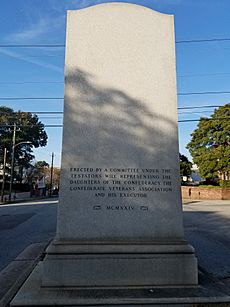Confederate Memorial (Wilmington, North Carolina) facts for kids

The memorial, before its dismantling and covering in June 2020. Note the missing bayonet.
|
|
| Coordinates | 34°14′03.44″N 77°56′45.2″W / 34.2342889°N 77.945889°W |
|---|---|
| Location | Wilmington, North Carolina |
| Designer | Henry Bacon and Francis Herman Packer |
| Material | Bronze and granite |
| Completion date | 1924 |
| Dedicated to | The Soldiers Of The Confederacy |
| Dismantled date | 2020 |
The Confederate Memorial was a monument in downtown Wilmington, North Carolina. It was built in 1924. A group called the United Daughters of the Confederacy helped create it. They worked with a veteran's estate and a Confederate veterans association.
The monument was very tall, about 40 feet (12 meters) high. It weighed 11 tons. It had a tall stone slab (called a stele) made of white granite. In front of it was a granite base. On top of the base stood a bronze statue of two soldiers. One soldier held a rifle, protecting another wounded soldier.
The monument was in the middle of a busy street. Over the years, it was hit by cars and sometimes damaged by vandals. In 2020, it became a focus of public protests. People were speaking out about fairness and justice.
Because of these protests and for public safety, the City of Wilmington removed the statue on June 25, 2020. A few days later, the city covered the remaining stone slab and base with a black cloth. This hid the words written on them.
The city government did not say where the monument was stored. They also did not announce when or if it would be put back together.
Contents
Who Paid for the Monument?
The money for the monument came from Gabriel James Boney. He was a soldier in the American Civil War. After the war, he became a rich mill owner in Wilmington.
Gabriel Boney was elected to the city council and later to the state government. He was also active in a group for Confederate veterans. He never married or had children. When he passed away in 1915, he left $25,000 to build "a suitable memorial to the Confederate soldier." This amount would be worth about $640,000 today.
Who Designed the Monument?
The monument was created by two main artists.
Henry Bacon: The Architect
The overall design of the monument was done by Henry Bacon. He was a famous architect. He also designed the well-known Lincoln Memorial in Washington, D.C.
Henry Bacon spent much of his younger years in Wilmington. He is also buried there.
Francis Herman Packer: The Sculptor
The bronze statue of the two soldiers was sculpted by Francis Herman Packer. He was from Germany but lived in Long Island, New York. He was a student of another famous sculptor, Augustus Saint-Gaudens.
Before this monument, Packer had sculpted another Confederate statue in Wilmington. It was called the George Davis Monument. That monument was also removed in June 2020.
What Did the Inscriptions Say?
The monument had several messages carved into its stone. These messages often reflected ideas from the "Lost Cause" narrative. This was a way of looking back at the Civil War that changed history.
On the Tall Stone Slab (Stele)
Front Side
The front of the stele had the years of the Civil War:
1861–1865
To the Soldiers of the Confederacy
Back Side
The back explained who built it:
Erected by a Committee under the
testator's Will representing the
Daughters of the Confederacy, the
the Confederate Veterans Association
and his Executor
MCMXXIV
MCMXXIV is Roman numerals for 1924.
On the Base (Pedestal)
The base had a poem and a Latin phrase:
Confederates blend your recollections
Let memory weave its bright reflections
Let love revive life's ashen embers
For love is life since love remembers
PRO ARIS ET FOCIS
This monument is a legacy of Gabriel James Boney
Born Wallace, NC 1846 – Died Wilmington, NC 1915
Meaning of 'Pro Aris et Focis'
The Latin phrase Pro Aris Et Focis means "For Altars and Hearths." This phrase has been used for hundreds of years, often by military groups. It is sometimes understood to mean "for God and Country."
In the context of the Lost Cause idea, this phrase was used to suggest that the Confederacy fought for home and faith. Historians say this idea was meant to hide the main reason for the Civil War, which was to keep slavery. Many historians believe these monuments were part of a larger effort to spread the "Lost Cause Narrative." This narrative tried to change how people remembered the Civil War. It also aimed to show that a period of rebuilding after the war, called Reconstruction, had ended.
Damage and Removal
The monument faced damage many times over the years.
Past Damages
- 1954: A car hit the statue and knocked it down. It was repaired and put back up.
- 1980s: The bayonet (a knife attached to a rifle) on one of the soldiers was damaged and replaced.
- 1999-2000: A car hit the monument again, knocking it off its base. It took a long time to repair. During the repairs, the crane used to put it back up fell, causing more damage. Eventually, it was fully restored to its spot.
- 2003: Someone broke off the bayonet again, and it was missing for many years.
- 2019: Someone threw orange paint on the memorial.
- 2020: In March, a white flag of surrender was placed in the statue's hands. In June, "Black Lives Matter" was painted on its base.
Removal in 2020
In June 2020, the city government blocked off the monument area. Then, in the early morning of June 25, the City of Wilmington removed the statue. They later covered the remaining parts with a black cloth.
In September 2020, Wilmington's mayor said the monument was removed for public safety. Most of the city council members said that deciding what to do with the city's Confederate monuments was not their top concern at that time.


